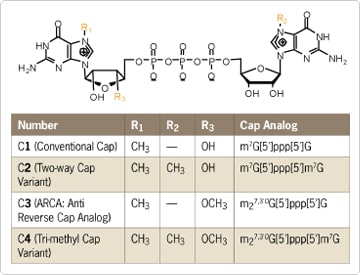Search
Synthesis and Biological Applications of Cap Analogs with Superior Translational Properties
Cap analogs are often used in in vitro transcription reactions for synthesis of 5' capped RNA molecules, which are generally more efficient templates for in vitro translation studies and are more stable templates for microinjection experiments. Applied Biosystems scientists continue to study ways to improve in vitro RNA research. Recently, they synthesized cap analog variants and evaluated their biological function [1–2].
The Role of the Cap Structure
The 5'-terminus of eukaryotic mRNA contains a unique cap structure recognized by enzymes involved in mRNA transport, translation, and metabolism. For in vitro transcription, conventional cap analogs (Figure 1, number C1) incorporate in either orientation; however, only mRNA containing forward-oriented caps are translated. To force incorporation in the forward orientation, modified cap analogs, including Ambion Anti Reverse Cap Analog (ARCA; Figure 1, structure C3), 2'-OH-modified analogs [1], and double-sided m7G analogs [2] (Figure 1, structures C2 and C4), have been developed.

Figure 1. Chemical Structure of Ambion Cap Analogs. m7G=7-methyl-guanosine; ppp=5', 5'-triphosphate bridge; m27,3'OG=7-methyl-3'-O-methylguanosine.

Figure 1. Chemical Structure of Ambion Cap Analogs. m7G=7-methyl-guanosine; ppp=5', 5'-triphosphate bridge; m27,3'OG=7-methyl-3'-O-methylguanosine.
Capping Efficiency
Capping efficiency of the methylated cap variants (structures C2–4) and conventional cap (structure C1) were tested in a T7 RNA polymerase in vitro transcription system, using the pTri-β-actin in vitro transcription vector (Ambion
MAXIscript® Kit) as a template and gel shift assays for analysis [2]. In these experiments, the conventional cap had a capping efficiency of 61%, and the cap variants had 51–56% capping efficiencies, indicating that methylated cap variants were successful substrates for T7 RNA polymerase.
Translational Efficiency
To assess biological function of the cap structures, compounds C1–4 were used in in vitro transcription reactions with a supercoiled plasmid containing poly(A)-tailed luciferase cDNA [2]. Transcript length and yield were compared to that of a control reaction (no cap analog). Analysis of the resulting mRNA revealed intact (no degradation) transcripts of similar size, and similar yields for reactions with each cap analog.
Luciferase transcripts were then transfected into HeLa cells for translation [2]. Protein production was monitored (luciferase activity measured at 8, 17, 22, and 45 hours post-transfection), and data were normalized to control reaction results. RNA with cap analog C4 was translated most efficiently (2.6-fold more activity than RNA with the conventional cap analog). RNA containing cap analogs C2 and C3 generated 1.6- and 2.2-fold more luciferase activity than RNA with the conventional cap analog, respectively. Presumably, the high translational activity for cap analog C4 is due to 3'-OH modification and additional N7 methyl group, which may increase stability of transcribed mRNA in cell culture.
Luciferase transcripts were then transfected into HeLa cells for translation [2]. Protein production was monitored (luciferase activity measured at 8, 17, 22, and 45 hours post-transfection), and data were normalized to control reaction results. RNA with cap analog C4 was translated most efficiently (2.6-fold more activity than RNA with the conventional cap analog). RNA containing cap analogs C2 and C3 generated 1.6- and 2.2-fold more luciferase activity than RNA with the conventional cap analog, respectively. Presumably, the high translational activity for cap analog C4 is due to 3'-OH modification and additional N7 methyl group, which may increase stability of transcribed mRNA in cell culture.
Ambion Cap Analogs
Applied Biosystems offers high quality cap analogs and variants for in vitro transcription (e.g., Ambion
mMESSAGE mMACHINE® T7 ULTRA Kits) and translation experiments. These molecules are also useful as highly specific inhibitors of protein synthesis initiation.
Scientific Contributors
Shanmugasundaram Muthian, Irudaya Charles, Zejun Xiao, Angie Cheng, Timothy Barta, and Anilkumar Kore • Applied Biosystems, Austin, TX
Scientific Contributors
Shanmugasundaram Muthian, Irudaya Charles, Zejun Xiao, Angie Cheng, Timothy Barta, and Anilkumar Kore • Applied Biosystems, Austin, TX
References1. Kore AR, Shanmugasundaram M, Charles I, Cheng AM, Barta TJ (2007) Synthesis and application of 2'-fluoro-substituted cap analogs.
Bioorg Med Chem Lett
17:5295–5299.
2. Kore AR, Shanmugasundaram M (2008) Synthesis and biological evaluation of trimethyl-substituted cap analogs. Bioorg Med Chem Lett18(3):880–884.
2. Kore AR, Shanmugasundaram M (2008) Synthesis and biological evaluation of trimethyl-substituted cap analogs. Bioorg Med Chem Lett18(3):880–884.